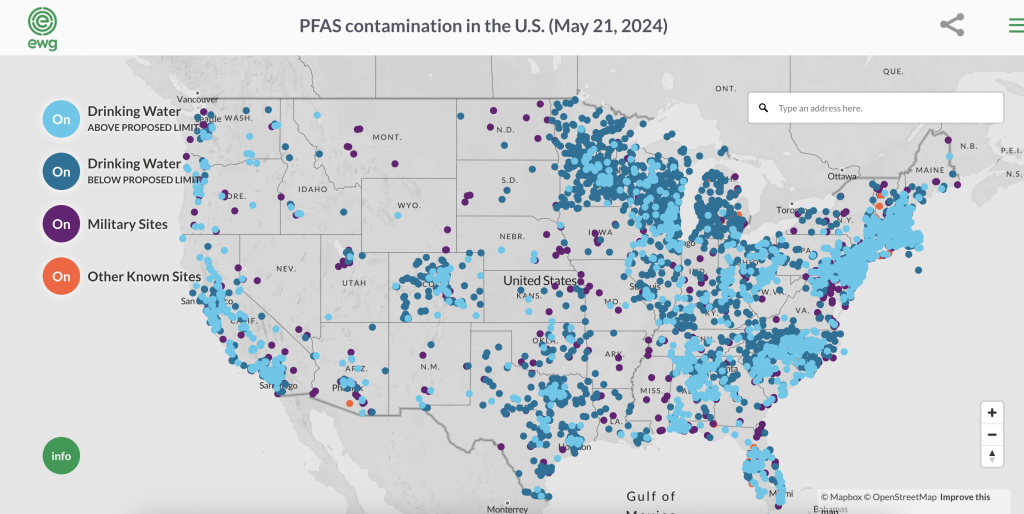
Stay Informed about the effects of PFAS
- PFAS compounds are a class of non-stick, waterproof, stain-resistant compounds used in consumer products and industry. Best known are PFOA, formerly used to make DuPont’s Teflon, and PFOS, formerly in 3M’s Scotchgard.
- The CDC identifies the main route of PFAS contamination as food and water ingestion. Some products possibly containing PFAS are stain-resistant carpets, water-resistant clothing, cleaning products, personal care and cosmetics products, paints, and fire-fighting foams
- Very low exposure to some PFAS chemicals has been linked to cancer, thyroid disease, weakened childhood immunity and many other health problems. Our own research has indicated that PFAS exposure is associated with numerous reproductive harms like preeclampsia, gestational hypertension, and post partum depression and other other long-term health effects such as poorer immunity and delayed neurobehavioral or physical development in the child.
- Tests of tap water, military bases and industrial sites have found PFAS contamination in more than 5,021 locations in 50 states, the District of Columbia and two territories. Drinking water for up to 200 million Americans may be contaminated with PFAS.
Learn about your own personal risk for PFAS exposure

PFAS contamination in the U.S. (May 21, 2024) – Environmental Working Group (EWG)
Know Your Risk
This map, create by the Environmental Working Group compiles known locations with high levels of PFAS in drinking water. Enter in your own address to understand your own personal risk:
Residents of communities with local sources of contamination and people who may have been exposed to high levels of PFAS at their workplace may seek a PFAS blood test to learn more about their exposure. This document provides information about what you can and can’t learn from a PFAS blood test, how to find a lab to conduct the testing, questions to ask a lab about their services, and tools to help you with interpretation and action.
Learn How to Protect Yourself
If you have concerns about your health, you can take steps to reduce your potential exposure to PFAS. Filters containing activated carbon or reverse osmosis membranes have been shown to be effective at removing PFAS from water supplies. All water treatment units require regular maintenance to work properly. Water treatment units that are not properly maintained will lose their effectiveness over time.
Donate To Help Vulnerable People in High-Exposure Areas from PFAS Exposure
People living in high-exposure areas to PFAS (per- and polyfluoroalkyl substances) face significant health risks due to the persistence and toxicity of these chemicals in the environment. Our mission is to help these communities by providing access to effective water filters that can reduce their exposure to PFAS. Not everyone can afford water filters, and it’s critical that people in high exposure areas get immediate access to filters. Even a small contribution can make key difference.
Donate to Help Vulnerable Mothers from PFAS Exposure
We also advocate for vulnerable women affected by PFAS contamination. Continuous PFAS exposure has been implicated in a number of harmful effects for women’s reproductive health. Exposure during pregnancy can be especially devastating towards the health of the mother and the health of her child. Join us to help women get the medical care that they need.
PFAS Resources in Different Languages
At the Feng Lab, we are committed to advocacy and ensuring that crucial information about PFAS is accessible. To support diverse communities, we share resources on PFAS exposure in multiple languages to empower individuals to protect their health and well-being.
EPA: Información básica sobre PFAS
Las sustancias perfluoroalquiladas y polifluoroalquiladas (PFAS, por sus siglas en inglés) son un grupo de agentes químicos que incluye PFOA, PFOS, GenX, y muchos otros agentes químicos. Son sumamente persistentes en el medio ambiente y en el cuerpo humano; es decir que no se degradan y pueden acumularse con el paso del tiempo. Existe evidencia de que la exposición a las PFAS puede causar efectos perjudiciales a la salud humana.
